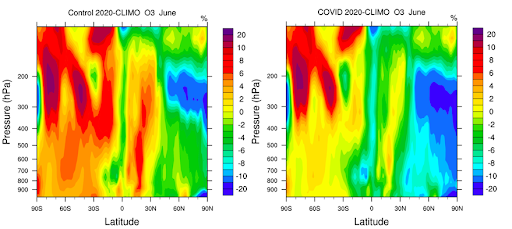Global change in air pollutants during the the 2020 COVID-19 Pandemic
In order to fight the COVID-19 pandemic, many countries implemented confinement measures in early 2020. Most emissions of air pollutants have decreased substantially during several months in different regions of the world. This unanticipated planet-wide experiment allows us to examine the response of the atmosphere's chemical system and in particular, the formation of secondary compounds such as ozone (O3). An international team has been assembled to address this question from a global and regional perspective.
In order to quantify anthropogenic emission changes during the lockdown periods, Adjustment factors (AFs) were derived for each economic sector and geographic region based on proxy of activity data (Doumbia et al., 2021). These were made on a daily basis when possible to reproduce such unprecedented and abrupt changes in emissions. Regional to continental total anthropogenic emissions showed reduction of nitrogen oxides (NOx) of up to 50% and volatile organic compounds (VOCs) of up to 30%.
We use the Community Atmosphere Model to assess the changes in the chemical composition to the changes in the surface emissions. We contrast simulations with and without these lockdown adjustments, including for the respective effects of the reductions in NOx and in VOCs emissions (Gaubert et al., 2020). We found that the ozone concentration increased only in a few NOx-saturated regions (northern China, northern Europe, and northern America) during the winter months of 2020. In other regions, where ozone is NOx-controlled, the concentration of ozone decreased.
Meteorological variability can lead to anomalies in the concentration of chemical species with magnitudes that are as large or even larger than the perturbations due to COVID-induced changes in the emissions. For instance, early and persistent cold conditions led to an exceptionally stable polar vortex and to record-low ozone in the Arctic. The influence of the pronounced Arctic ozone depletion (300-100 hPa) on tropospheric ozone (500-300 hPa) poleward of 45°N was substantial, as shown on the left panel of the figure below.
Zonally averaged ozone in the free troposphere during Northern Hemisphere spring and summer is found to be 5%–15% lower than 19-yr climatological values (Figure below, right panel), in good agreement with ozone sondes and ground based High-resolution Fourier transform infrared (FTIR) observations (Steinbrecht et al., 2020). About one third of this anomaly is attributed to the reduction scenario of air traffic during the pandemic, another third to the reduction scenario of surface emissions, the remainder to 2020 meteorological conditions (Bouarar et al., 2021).

: Relative variations (percent) in the zonally averaged concentrations of ozone for June 2020 relative to the 2001-2019 climatology as a function of latitude and pressure for baseline conditions (left) and for COVID-19 situation (right). The ozone decrease seen in the Northern hemisphere relative to climatology is a result of the exceptionally large ozone reduction that took place in the Arctic polar lower stratosphere in Spring 2020.
References:
Bouarar, I., Gaubert, B., Brasseur, G. P., Steinbrecht, W., Doumbia, T., Tilmes, S., et al. (2021). Ozone anomalies in the free troposphere during the COVID-19 pandemic. Geophysical Research Letters, 48, https://doi.org/10.1029/2021GL094204.
Doumbia, T., Granier, C., Elguindi, N., Bouarar, I., Darras, S., Brasseur, G., Gaubert, B., et al. (2021). Changes in global air pollutant emissions during the COVID-19 pandemic: a dataset for atmospheric modeling, Earth Syst. Sci. Data, 13, 4191–4206, https://doi.org/10.5194/essd-13-4191-2021.
Gaubert, B., Bouarar, I., Doumbia, T., Liu, Y., Stavrakou, T., Deroubaix, A., Darras, S., Elguindi, N., Granier, C., Lacey, F., Müller, J. F., Shi, X., Tilmes, S., Wang, T., and Brasseur, G. P. (2021). Global changes in secondary atmospheric pollutants during the 2020 COVID-19 pandemic, J. Geophys. Res.-Atmos., 126, https://doi.org/10.1029/2020JD034213.
Steinbrecht, W., Kubistin, D., Plass-Dülmer, C., Davies, J., Tarasick, D. W., Gathen, P., et al. (2021). COVID-19 crisis reduces free tropospheric ozone across the Northern Hemisphere. Geophysical Research Letters, 48, https://doi.org/10.1029/2020GL091987.